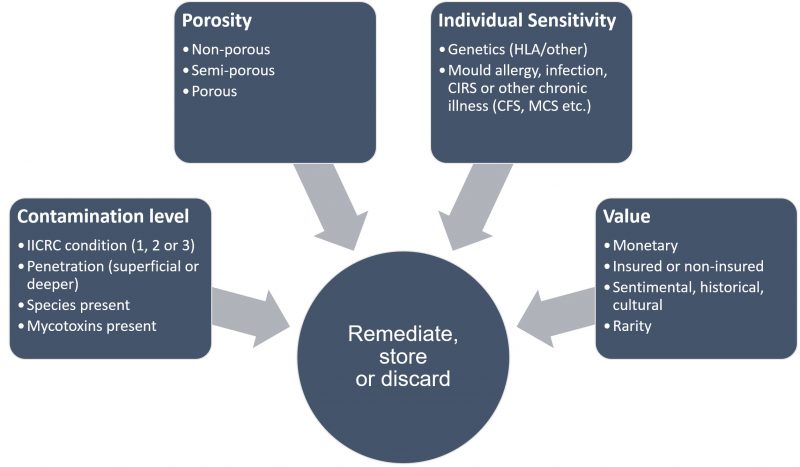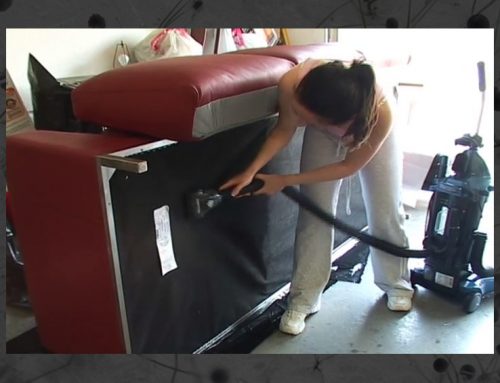Summary / Table of Contents
- The most important factor in preventing mould growth is stopping the cause of moisture or water ingress
- Dealing with acute water ingress
- Drying of building structures and contents are needed within (ideally) 48 hours by
- Increasing heat to 27 C using heaters
- Using an air conditioners dehumidification setting and/or portable dehumidifiers to take moisture out of the room
- Using fans to increase water evaporation
- Drying of building structures and contents are needed within (ideally) 48 hours by
- Knowing if you have chronic water damage/mould growth
- Mould and other microbes are often not visible to the naked eye or can be hidden in wall, ceiling or subfloor cavities
- Look for signs of water damage, or damp musty smells, in addition to visible mould
- Another red flag is if the occupants are dealing with chronic health issues, especially if symptoms improve away from home
- There are various professionals that can inspect and test a building see the TMSA List.
- They should follow the D7338–14 Standard guide for assessment of fungal growth in buildings.
- Mould and other microbes are often not visible to the naked eye or can be hidden in wall, ceiling or subfloor cavities
- Professional Mould Remediation
- If remediation is warranted, seek an IICRC certified mould remediator. IICRC.org.
- The aim of remediation is source removal of mould, not to kill it, 75% of mould is non-viable (dead) and can still contribute to health issues
- Basics of sorting your contents
- Porosity of the material (porous, semi-porous, non-porous)
- Level of mould contamination
- condition 1: normal fungal ecology; condition 2: settled spores or fragments; condition 3: actual mould growth
- Decision matrix for contents with visible mould
- In general anything with visible mould of low value should be discarded
- Basics of cleaning your contents (and building structures)
- Condition 1 items: generally need no cleaning, however, it may be prudent to assume all items are condition 2 unless tested
- Condition 2 items:
- Porous: Clothing and textiles can be washed via regular washing (hot water) with normal laundry liquid/powder.
- Semi-porous/non-porous
- HEPA vacuum
- Damp wipe with a microfibre cloth dipped in warm water with dish wash liquid
- Should be done by a healthy person and/or with appropriate PPE
- Damp wiping explained
- Fogging, ozone, spraying and antimicrobials/biocides
- Exit mould, bleach, vinegar, clove oil/tea tree oil, Concrobium, Forcefield, Goldmorr, enzyme sprays, ozone, or any other number of mould killing fog, gas and spray solutions, are not recommended as the aim is to remove not kill mould. Some will also aggravate those with chemical sensitivities which is a significant portion of those with mould illness.
- Advanced Topics
- References
THE BASICS OF SORTING YOUR CONTENTS
The two main factors when considering what can be remediated or kept, and what should be discarded are the porosity of the material and the level of contamination. More factors are outlined in the advanced topic What do I do with my contents?
The Three Types of Porosity
The IICRC R520, 2015 (p135) defines three states of porosity for materials and contents. Examples are from the IICRC, except where noted.
Porous
Materials that absorb or adsorb moisture and, if organic, easily support fungal growth e.g.
- clothing & other textiles
- padded or upholstered items
- leather
- taxidermy
- paper goods
- many types of fine art
- carpet*
Semi-porous
Materials that absorb or adsorb moisture slowly and, if organic, can support fungal growth e.g.
- unfinished wood
- masonry
- particle board/MDF*
- concrete*
- brick*
- gypsum wallboard (drywall)*
Non-porous
Materials that do not absorb or adsorb moisture, or those that have been surface treated and do not easily support fungal growth e.g.
- finished wood+
- glass
- metal
- plastic+
* From various sources
+ Considered porous by Petrison & Johnson, 2015
Condition 1 – Normal fungal ecology
An indoor environment that may have settled spores, fungal fragments, or traces of actual growth whose identity, location, and quantity are reflective of a normal fungal ecology for a similar indoor environment.
Condition 2 – Settled spores or fungal fragments
An indoor environment that is primarily contaminated with settled spores or fungal fragments that were dispersed directly or indirectly from a Condition 3 area, and which may have traces of actual growth.
Condition 3 – Actual growth
An indoor environment contaminated with the presence of actual mold growth associated spores, and fungal fragments. Actual growth includes growth that is active or dormant, visible or hidden.
Key
Can be remediated/worth remediating. Specialist services are sometimes required.
Possibly can be remediated/worth remediating. Specialist services are normally required.
Not able to be remediated/not worth remediating.
For sentimental/important documents and photos, consider scanning them in (while wearing PPE), then disposing of them.
Adapted from Mold Masterclass: Mold and Mycotoxin Training Course
Condition 1
Condition 1 items generally need no cleaning. However, it may be prudent to assume all items are condition 2 unless tested.
Condition 2
Porous items
- Clothes, textiles, bedding: Launder normally, with usual laundry detergent, in hot water and either dry in sun or use a dryer (preferably condensing/heat-pump type).
- Who says this? Dr. Shoemaker, Nicole Bijlsma and the IICRC.
- What do others say? Bloggers and those on social media suggest borax, vinegar, Canesten and EC3 among others, in the wash.
- Books/documents/photos: HEPA vacuum every page. Professionals can air wash books by the tub.
Semi-porous/non-porous
- HEPA vacuum item or use a ducted vacuum. Ideally, do it outside if possible.
- Damp wipe using water with dilute dish liquid and microfibre cloths (see next section)
Condition 3
Porous items
- Discard
Semi-porous/non-porous
- May be able to be remediated but physical removal, often via sanding or media blasting will be required.
See the decision matrix for contents with visible mould, also.
ADVANCED TOPICS
Contents in depth
For people who are mould sensitive/those with CIRS, there are more things to consider beyond the IICRC guidelines. These patients are hypersensitive to inflammagens (mould spores, mould fragments, bacteria) and their biotoxins from water-damaged buildings so need to consider each possession against a number of factors.

If this seems overwhelming, one possibility for CIRS patients is to store possessions, as long as they are dry, in water-tight plastic tubs in storage facilities or in dry parts of the house. When further along in their mould journey, the tubs can be opened, and the patient can see if they are reacting to the contents and then act accordingly.
Be very careful in bringing contaminated, or potentially contaminated possessions, into a clean home. Possessions of condition 3, and perhaps even condition 2, nature can cross-contaminate buildings and other contents.
References
- ANSI/IICRC R520 Reference guide for professional mold remediation – third edition. (2015). Institute of inspection cleaning and restoration certification.
- ANSI/IICRC S520 Standard for professional mold remediation – third edition. (2015). Institute of inspection cleaning and restoration certification.
- Banta, J. (2018-20). Prescriptions for a Mold Controlled Home. Pre-print.
- Barnes et al. (2016). Home assessment and remediation. J allergy clin immunol pract, 4(3). doi: 10.1016/j.jaip.2016.01.006
- Bijlsma, N. (2017). Healthy home, healthy family. Australian college of environmental studies.
- D7338 – 14 Standard guide for assessment of fungal growth in buildings. (2014). ASTM International
- IEP Radio: mold remediation: remediation & environmental cleaning. YouTube. Part 1 | Part 2 | Part 3 | Part 4
- Mold Illness Made Simple Online Course
- Petrison, L. & Johnson, E. (2015, October 5). The Mold Avoider’s Dilemma: What Should I Do About My Stuff? Paradigm Change.
- Preventing Mold After Floods and Extreme Weather with Nicole Bijlsma. (2022, March 6). Mold Illness Made Simple.
- Prezant, Weekes, Miller (editors). (2008). Recognition, evaluation, and control of indoor mold – 1st edition. American Industrial Hygiene Association (AIHA).
- Schrantz, M., Banta, J., Charlton, J., Heiblum, J., Johnson, K., McMahon, S., Schwartz, L., Weatherman, G., Weber, B., Vukelic, A., Shoemaker, R. (2021). Indoor Environmental Professional Panel of Surviving Mold Consensus Statement for Microbial Remediation 2020. Medical Research Archives, 9(1), 1-25. doi: 10.18103/mra.v9i1.2327
- Schwartz, L. (2018). Suggested protocol for small particle cleaning (SPC) and preparation of home prior to air treatments. Safestart environmental.



